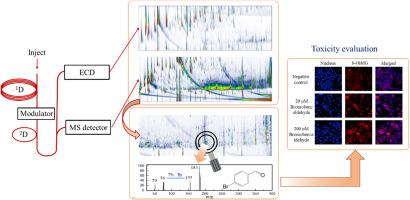Journal of Hazardous Materials ( IF 12.2 ) Pub Date : 2020-09-25 , DOI: 10.1016/j.jhazmat.2020.124103 Xin-Yang Zhang , Yao Lu , Ye Du , Wen-Long Wang , Lu-Lin Yang , Qian-Yuan Wu

|
Ozonation might increase the risk of wastewater due to byproduct formation, especially in the presence of bromide. In this study, a new analytical method was developed to identify new brominated disinfection byproducts (Br-DBPs) during ozonation, using comprehensive two-dimensional gas chromatography-single quadrupole mass spectrometry (GC×GC-qMS) connected with an electron capture detector in parallel. The obtained data were analyzed using a mass-to-charge ratio (m/z) difference extraction method. Over 1304 DBPs were detected in an ozonated phenylalanine solution. Further screening of 635 DBPs was conducted using the m/z difference extraction method. Finally, the structures for 12 Br-DBPs were confirmed and for 4 Br-DBPs were tentatively proposed by comparison with the NIST library and standard compounds. Eight of the confirmed Br-DBPs are first reported and identified: 2-bromostyrene, 1-bromo-1-phenylethylene, 2-bromobenzaldehyde, 3-bromobenzaldehyde, 4-bromobenzaldehyde, 2-bromophenylacetonitrile, 3-bromophenylacetonitrile and 4-bromophenylacetonitrile. These DBPs and 2,4,6-tribromophenol were detected at nanogram- to microgram-per-liter concentrations during ozonation of authentic water samples like algal bloom waters, wastewater treatment plant effluents, and surface water. The toxicities of these compounds were generally higher than that of bromate. The developed analytical method is a powerful technique for analyzing complex compounds and provides a novel way of identifying byproducts in future studies.
中文翻译:

全面的GC×GC-qMS,具有质荷比差异提取方法,可在臭氧化过程中识别新的溴化副产物及其毒性评估
臭氧化可能会由于副产物的形成而增加废水的风险,尤其是在存在溴化物的情况下。在这项研究中,开发了一种新的分析方法,该方法使用全面的二维气相色谱-单四极杆质谱(GC×GC-qMS)与电子捕获检测器相连,在臭氧氧化过程中识别新的溴化消毒副产物(Br-DBPs)。平行。使用质荷比(m / z)差异提取方法分析获得的数据。在臭氧化的苯丙氨酸溶液中检测到超过1304种DBP。使用m / z进一步筛选635个DBP差异提取方法。最后,通过与NIST文库和标准化合物的比较,确定了12种Br-DBP的结构,并初步提出了4种Br-DBP的结构。首次报告并鉴定了八种已确认的Br-DBP:2-溴苯乙烯,1-溴-1-苯基乙烯,2-溴苯甲醛,3-溴苯甲醛,4-溴苯甲醛,2-溴苯基乙腈,3-溴苯基乙腈和4-溴苯基乙腈。这些DBP和2,4,6-三溴苯酚在对真水样本(如藻类水,废水处理厂废水和地表水)进行臭氧化处理时,每升浓度为纳克至微克。这些化合物的毒性通常高于溴酸盐。











































 京公网安备 11010802027423号
京公网安备 11010802027423号